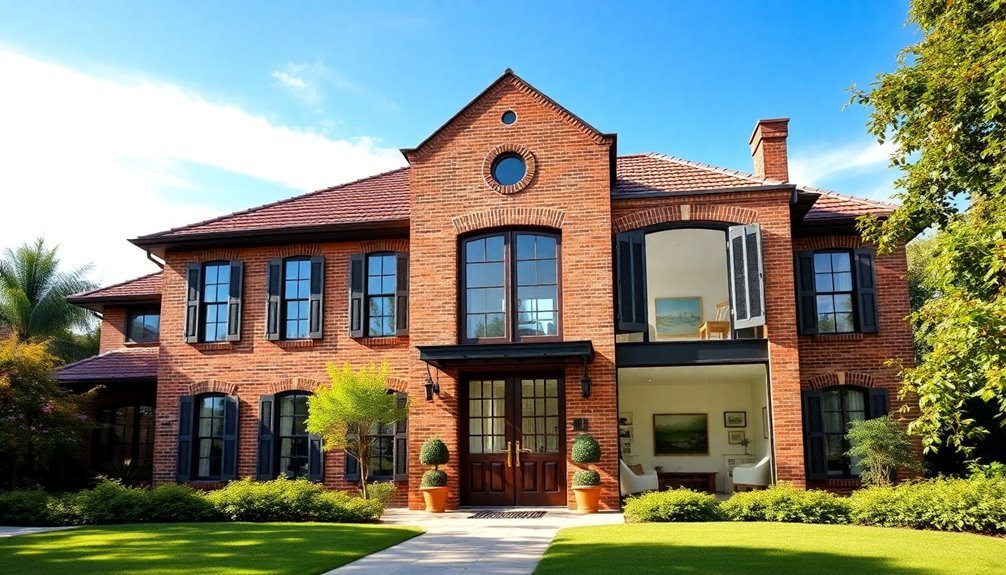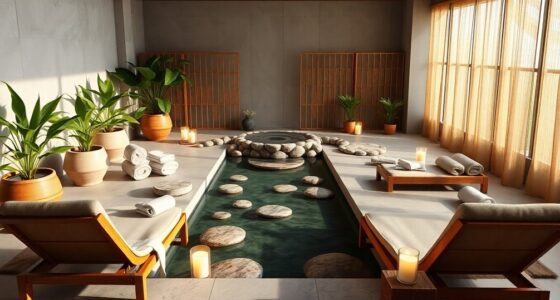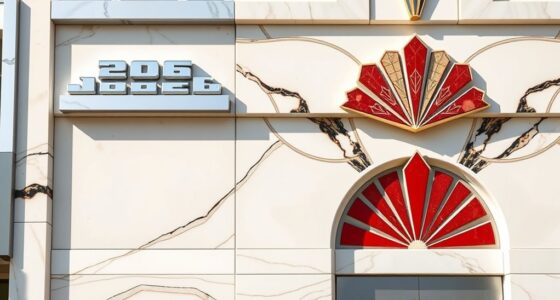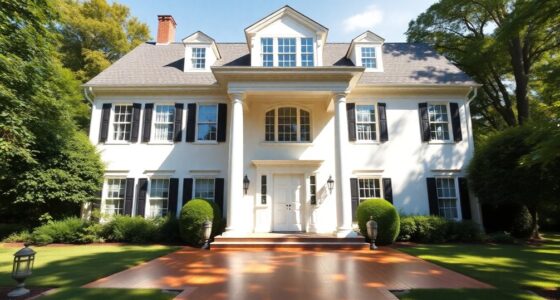If you're looking to blend old and new in your home design, the neo-eclectic style might be the perfect fit. This approach mixes elements from various architectural styles, like Colonial and Craftsman, with modern materials such as glass and steel. You'll notice varied rooflines, expansive windows, and a focus on symmetry, creating visual harmony. Additionally, eco-friendly features and flexible layouts enhance both sustainability and functionality. The result is inviting spaces that maintain a sense of history while embracing contemporary aesthetics. There's a lot more to explore about how to bring this style into your home.
Key Takeaways
- Neo-eclectic style merges traditional architectural elements with modern aesthetics, creating a unique and inviting appearance.
- It features varied rooflines and materials like brick and stucco, enhancing visual harmony and curb appeal.
- Large windows maximize natural light and blur indoor-outdoor boundaries, promoting a sense of spaciousness.
- Sustainable practices, such as energy-efficient materials and smart home technology, are integral to neo-eclectic design.
- Landscapes often incorporate native plants and stone features, balancing low maintenance with environmental harmony.
Understanding Neo-Eclectic Style

When you explore Neo-Eclectic style, you'll discover an enchanting blend of traditional and modern architectural elements that creates a distinctive look. This design trend emerged in the late 20th century, breaking away from minimalist aesthetics to embrace individuality in home design ideas.
You'll notice varied rooflines and a mix of materials like brick, stucco, and wood, which add visual interest. Large, expansive windows invite natural light, enhancing the warmth of the space.
Neo-Eclectic homes often showcase influences from Colonial, Victorian, and Craftsman styles, making them visually diverse yet cohesive. Additionally, this style incorporates sustainable practices, using energy-efficient materials and modern technology, marrying beauty with functionality.
It's a perfect choice for those seeking uniqueness in their homes.
Key Architectural Styles
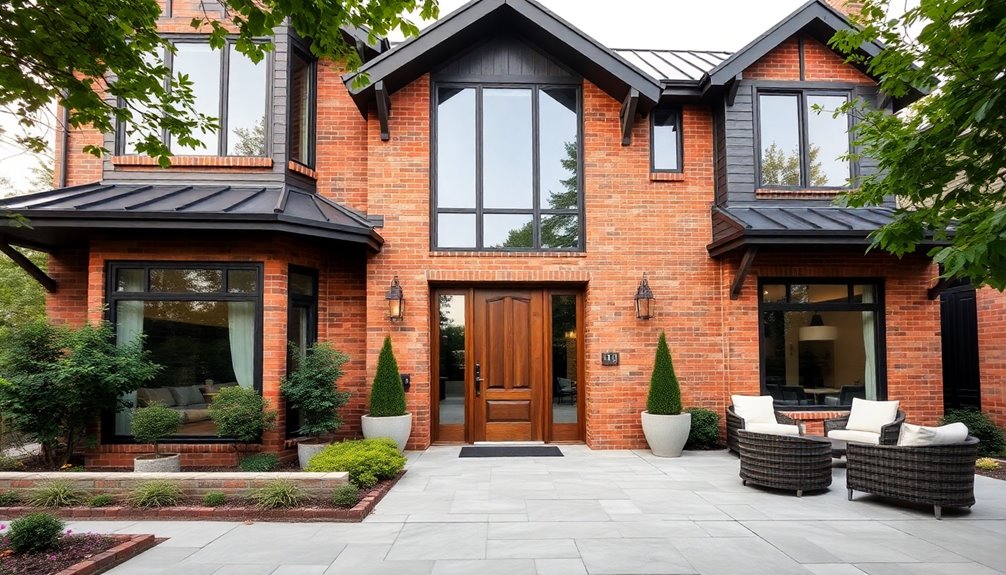
Key architectural styles within the Neo-Eclectic movement offer a rich tapestry of influences that shape its unique aesthetic.
You'll often find elements from Colonial Revival, Craftsman, and Mediterranean styles, blending traditional charm with modern flair. This design approach emphasizes symmetry and balance, featuring central entrances and multi-pane windows that draw the eye and enhance classic appeal.
Many neo-eclectic homes incorporate modern materials like glass and steel, creating striking contrasts that bridge old and new. Expansive glass windows are hallmarks of these designs, maximizing natural light while connecting indoor and outdoor spaces.
Landscaping typically leans towards minimalist designs, providing a clean and inviting outdoor environment that complements the contemporary aspects of the architecture, ensuring a cohesive overall look. Additionally, the use of natural materials in landscaping and home design further enhances the eco-friendly ethos often found in neo-eclectic homes.
Innovative Home Design Trends
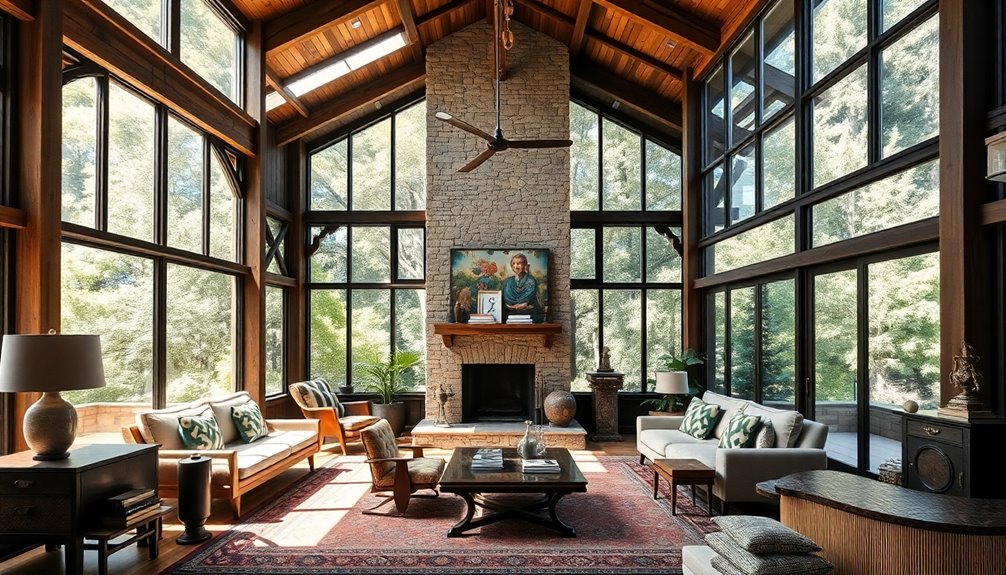
When you think about innovative home design trends, consider how architectural style fusion can create unique living spaces.
Sustainable design practices aren't just eco-friendly; they also enhance the beauty of your home while promoting energy efficiency.
Plus, open space functionality allows for a versatile layout that adapts to your lifestyle, making your home both stylish and practical.
Architectural Style Fusion
As homeowners seek to express their individuality through design, architectural style fusion has emerged as a fascinating trend in innovative home design.
Neo-eclectic homes often blend traditional styles like Colonial Revival and Victorian with contemporary finishes, creating a unique aesthetic. You'll notice expansive glass windows that marry classic warmth with modern open-space concepts.
The minimalist landscaping enhances the clean lines typical of contemporary architecture, promoting an inviting outdoor environment.
This fusion allows you to personalize your space, integrating historical elements while meeting modern living needs through innovative layouts. Additionally, the use of natural materials like wood and stone can further enhance the connection between the old and the new in your design.
Sustainable Design Practices
Blending traditional and modern elements in neo-eclectic homes opens the door to innovative sustainable design practices that enhance both style and functionality.
You can incorporate energy-efficient materials like insulated windows and eco-friendly insulation to boost comfort while reducing energy use. Consider adding renewable energy solutions such as solar panels and geothermal heating to lessen your carbon footprint and save on utility bills.
Using reclaimed or recycled materials not only conserves resources but also minimizes waste during construction and renovation. Additionally, integrating green roofs and rainwater harvesting systems improves stormwater management and fosters natural habitats.
Finally, smart home technology allows you to monitor and control energy consumption in real-time, maximizing efficiency and convenience in your sustainable living space. Moreover, incorporating eco-friendly wood stoves can further enhance your home's sustainability by providing efficient and renewable heating options.
Open Space Functionality
Open space functionality transforms how you experience your home, creating fluid environments that encourage interaction and adaptability.
By merging kitchen, dining, and living areas, these designs foster social gatherings and family connections. Large glass windows not only enhance natural light but also connect indoor and outdoor spaces, making your home feel more expansive and inviting.
Flexible floor plans let you adapt rooms for various purposes, whether it's a home office or a playroom. Minimalist landscaping with clean lines reduces maintenance while seamlessly blending your home with its surroundings.
Utilizing modern materials like glass and steel enhances the sleek aesthetic, ensuring durability and functionality in your open spaces. This approach redefines contemporary living, making your home a dynamic, multifunctional space. Additionally, incorporating IRAs for retirement savings can provide financial security that complements your innovative home design.
Contemporary Enhancements in Design
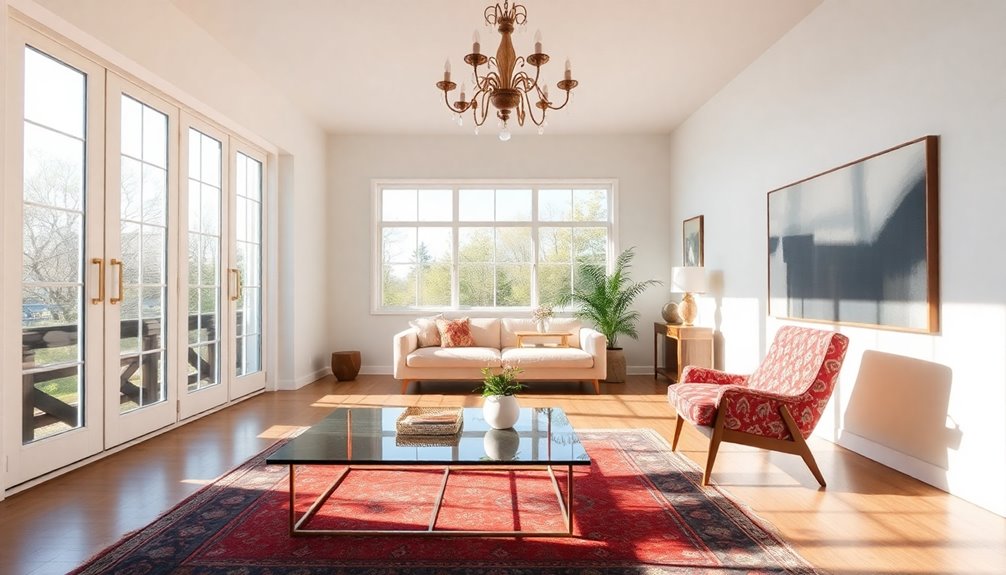
While many homeowners appreciate the charm of traditional architecture, contemporary enhancements in neo-eclectic design bring a fresh perspective that marries classic elements with modern innovation.
You'll notice striking facades that blend traditional features with materials like glass and steel. Expansive glass windows flood your interior with natural light, creating a bright and inviting atmosphere.
Minimalist landscaping complements the clean lines of neo-eclectic homes, ensuring your outdoor space feels cohesive. You might also appreciate the use of monochromatic color schemes, which allow bold contrasts between classic details and modern finishes.
Finally, these designs often prioritize sustainability, incorporating energy-efficient materials that resonate with eco-conscious homeowners. Together, these elements create a harmonious balance between the old and the new.
Essential Design Features

Neo-eclectic style homes showcase a variety of design features that highlight their unique character.
You'll often see a blend of traditional elements like gabled roofs and brick facades paired with modern materials such as large glass windows and sleek finishes.
Symmetry and balance are essential, evident in central entrances and multi-pane windows that offer both classic appeal and functionality.
Innovative, minimalist landscaping enhances the modern vibe, creating clean outdoor spaces that complement the architecture.
A diverse color palette, mixing monochromatic schemes with bold accents, adds visual interest while keeping the home inviting.
Expansive glass features maximize natural light, promoting bright, airy interiors that seamlessly connect indoor and outdoor spaces, a hallmark of contemporary living. Additionally, incorporating advanced filtration systems can further improve indoor air quality, creating a healthier living environment.
Drawing Design Inspirations
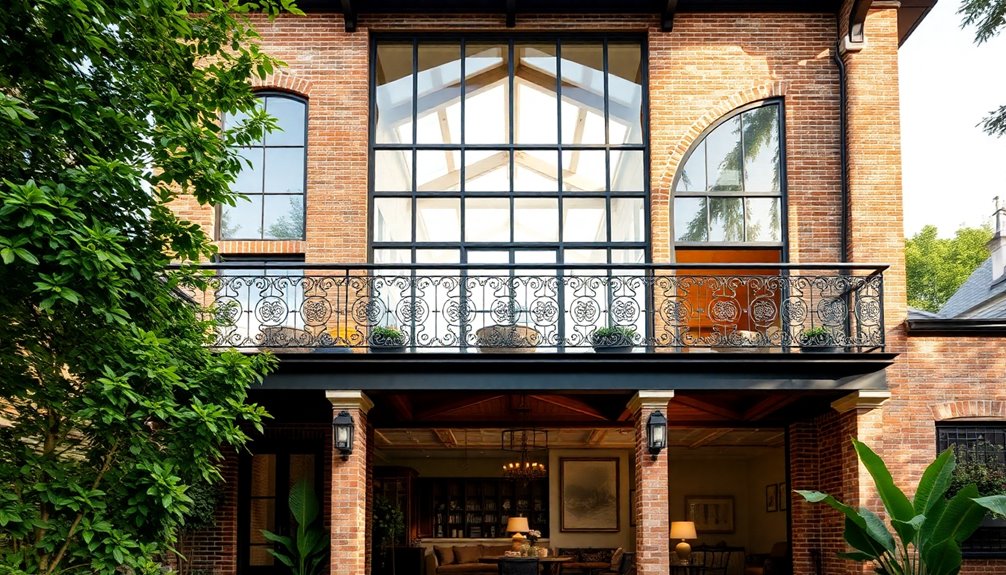
How can you create a home that reflects both history and modernity? Begin by blending historical architectural elements with contemporary designs. Incorporate features like symmetrical facades and ornate detailing, while utilizing modern materials for a fresh look. Additionally, consider incorporating natural materials like wood and stone to enhance the overall warmth and texture of your space.
Here's a quick comparison of design inspirations:
| Historical Elements | Modern Features |
|---|---|
| Colonial Revival | Open floor plans |
| Victorian detailing | Expansive glass windows |
| Classic color palettes | Monochromatic schemes |
| Energy-efficient materials | Sustainable design practices |
| Traditional charm | Contemporary functionality |
Importance of Symmetry

Incorporating historical elements into your home design naturally leads to an appreciation for symmetry, which plays a significant role in achieving visual harmony.
Symmetry enhances curb appeal and provides order to your home's architectural design.
Consider these benefits of symmetrical design:
- Visual Harmony: Creates balance that's pleasing to the eye.
- Curb Appeal: Attracts attention with its orderly appearance.
- Familiarity: Evokes comfort and a sense of tradition.
- Natural Light: Evenly spaced windows improve illumination throughout the day.
- Structural Integrity: Balanced designs help distribute weight more evenly.
Moreover, understanding client preferences is crucial for creating a harmonious and personalized design.
Modern Materials and Aesthetics

As you explore the essence of modern home design, you'll find that the use of contemporary materials like glass and steel not only enhances flexibility but also creates striking contrasts with traditional architectural features.
Neo-eclectic homes often showcase expansive glass windows, maximizing natural light and fostering a bright, airy atmosphere that complements modern living.
The integration of sleek finishes contributes to a contemporary aesthetic, reflecting current trends while maintaining historical charm.
Monochromatic color schemes further emphasize the fusion of old and new, allowing bold contrasts to shine.
Minimalist landscaping typically partners with these designs, creating clean outdoor spaces that harmonize with the home's modern materials and overall aesthetic, making your environment feel inviting and stylish. Additionally, incorporating vintage furniture can enhance the overall eclectic vibe of the space.
Landscaping for Neo-Eclectic Homes

While embracing the diverse architectural styles of neo-eclectic homes, landscaping plays an essential role in enhancing their visual appeal.
You can create an inviting outdoor space that complements your home by focusing on minimalist design and functional elements.
Consider these landscaping ideas:
- Native plants for low maintenance and biodiversity.
- Stone pathways and patios to blend with architectural features.
- Water features like ponds or fountains for tranquility.
- Hardscaping elements such as retaining walls for structure.
- Strategic lighting to highlight your home's best features.
Balancing Old and New Elements
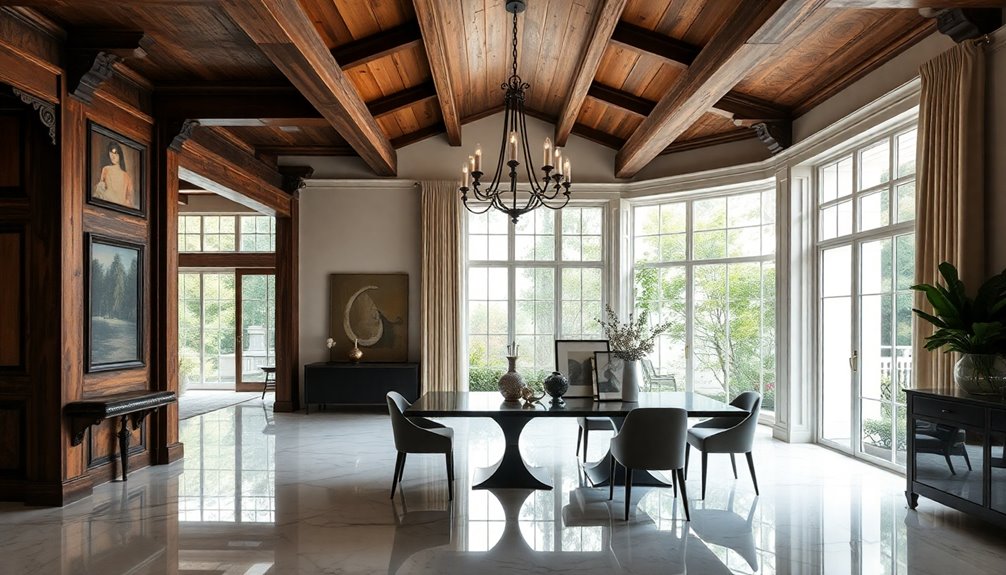
Balancing old and new elements in neo-eclectic home design creates a unique aesthetic that appeals to a wide range of tastes. You can achieve this harmony by combining traditional architectural features, like gabled roofs and ornate detailing, with modern materials such as glass and steel.
Emphasizing symmetry and balance helps you incorporate classic elements, like multi-pane windows, alongside sleek contemporary finishes. Retaining historical details, such as brick facades or intricate woodwork, while integrating modern innovations effectively bridges the gap between past and present.
Choose monochromatic color schemes to create striking contrasts that reinforce this balance. Ultimately, opt for minimalist landscaping that complements both the old-world charm and modern simplicity to enhance your property's overall visual appeal. Additionally, incorporating natural materials like wood can further enrich the aesthetic and provide warmth to the overall design.
Frequently Asked Questions
What Are the Characteristics of a Neo-Eclectic Style House?
A neo-eclectic style house combines traditional and modern elements, creating a unique look.
You'll notice features like gabled roofs and brick facades paired with glass and steel.
Inside, open floor plans and large windows let in ample light, making the space feel airy.
The landscaping is minimalist, using clean lines and native plants.
Color schemes often mix classic hues with bold shades, enhancing the home's visual appeal while focusing on sustainability and energy efficiency.
What Are the Neo-Eclectic Styles of the 1960's and 1970's?
In the 1960s and 1970s, you'd notice neo-eclectic styles mixing traditional and contemporary elements.
These homes often featured bold colors, varied rooflines, and a blend of materials like brick and wood.
You'd see asymmetrical designs, large windows for natural light, and open floor plans tailored to modern family lifestyles.
Popular elements included split-level layouts and expansive porches, showcasing an embrace of historical inspirations while promoting personalization in residential design.
What Is the Eclectic Mix of Architecture?
The eclectic mix of architecture combines elements from different styles and periods, allowing you to create a unique aesthetic.
You'll find traditional features like ornate moldings alongside modern materials like steel and glass.
This approach encourages creativity, as you blend contrasting styles and colors to express your personality.
What Materials Are Used in Neo Eclectic Architecture Style?
In neo-eclectic architecture, you'll find a fascinating mix of materials that create a unique aesthetic.
You'll often see traditional elements like brick, wood, and stone paired with modern touches like steel and glass.
Stucco is commonly used for its smooth finish, while large glass windows flood the space with natural light.
The roofing blends traditional shingles with metal panels, ensuring durability and visual appeal.
This combination makes for an inviting and dynamic space.
Conclusion
In embracing neo-eclectic style, you're crafting a harmonious dance between the past and the present. By blending architectural influences and contemporary elements, your home becomes a canvas of creativity and personal expression. Remember, it's not just about aesthetics; it's about creating a space that resonates with your identity. As you balance old and new, every room tells a story, inviting warmth and character into your life. So, go ahead—let your home reflect the beautiful tapestry of your journey.
